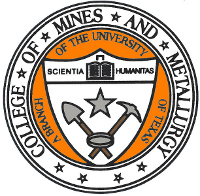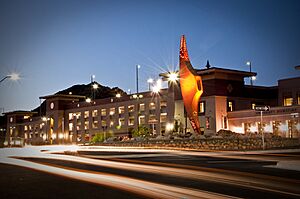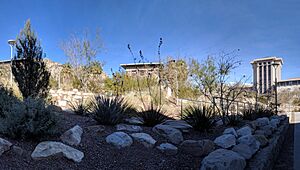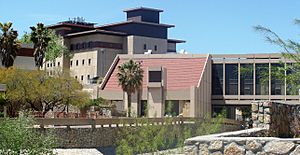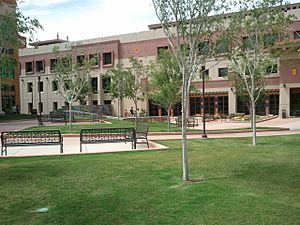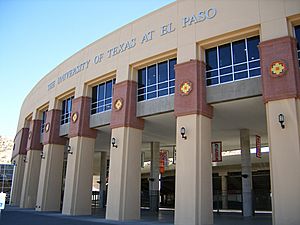University of Texas at El Paso facts for kids
 |
|
|
Former names
|
State School of Mines and Metallurgy (1913–1919) Department of Mines and Metallurgy of University of Texas (1919–1921) College of Mines and Metallurgy of the University of Texas (1921–1949) Texas Western College of the University of Texas (1949–1966) Texas Western College of The University of Texas at El Paso (1966) |
|---|---|
| Motto | Scientia et Humanitas (Latin) |
|
Motto in English
|
"Knowledge and Refinement" |
| Type | Public research university |
| Established | April 16, 1913 |
|
Parent institution
|
University of Texas System |
| Accreditation | SACS |
|
Academic affiliations
|
|
| Endowment | $386.8 million (FY2024) (UTEP only) $47.47 billion (FY2024) (system-wide) |
| Budget | $627.3 million (FY2025) |
| President | Heather Wilson |
|
Academic staff
|
1,414 (fall 2023) |
|
Administrative staff
|
414 (fall 2024) |
|
Total staff
|
4,462 (fall 2024) |
| Students | 25,039 (fall 2024) |
| Undergraduates | 21,118 (fall 2024) |
| Postgraduates | 3,921 (fall 2024) |
| Location |
,
,
United States
|
| Campus | Large City, 366 acres (1.48 km2) |
| Newspaper | The Prospector |
| Colors | Dark blue, orange, and silver accent |
| Nickname | Miners |
|
Sporting affiliations
|
NCAA Division I FBS – CUSA |
| Mascot | Paydirt Pete |
 |
|
The University of Texas at El Paso (UTEP) is a large public university located in El Paso, Texas. It was started in 1913 as the State School of Mines and Metallurgy. UTEP is the third oldest part of the University of Texas System.
UTEP is known as a top research university, meaning it does a lot of important studies. It is also the biggest and oldest university that serves many Hispanic students in the United States.
The campus sits on hills overlooking the Rio Grande river. You can even see Ciudad Juárez in Mexico from there! The campus has the Sun Bowl stadium, where a big college football game called the Sun Bowl happens every winter. Many buildings on campus have a special design called Dzong architecture, which looks like buildings from Bhutan and Tibet.
Contents
Discovering UTEP's History
How UTEP Began
On April 16, 1913, a law was signed to create a new school in Texas. This school later became UTEP. It was the second oldest school in the University of Texas system. The school first opened on September 28, 1914, with 27 students. It was located near Fort Bliss. The school was first called the State School of Mines and Metallurgy. There's even an old practice mine shaft still on campus! By 1916, 39 students were enrolled, including the first two female students, Ruth Brown and Grace Odell.
The Unique Campus Design
On October 29, 1916, a big fire destroyed the main building of the school. This meant the school had to move. In 1917, new buildings were built on the current campus site. Kathleen Worrell, whose husband was the school's dean, saw pictures of buildings from the country of Bhutan in a magazine. These buildings had a special style called dzong architecture, with sloped sides and overhanging roofs.
She noticed that the mountains around El Paso looked similar to the mountains in Bhutan. So, she suggested that the new school buildings be built in this unique style. Everyone liked the idea! Since then, new buildings, including the Sun Bowl football stadium, have continued to use this special design.
Changing Names and Big Moments
The school's name changed a few times over the years. In 1919, it became the Department of Mines and Metallurgy. Then, in 1920, it was called the College of Mines and Metallurgy of the University of Texas. In 1949, its name changed again to Texas Western College of The University of Texas.
Some important things happened at UTEP during this time. In 1961, the first group of Peace Corps volunteers trained there. The Sun Bowl Stadium was built in 1963. And in 1966, the UTEP basketball team won the national championship!
UTEP Today: A New Name and More Success
In 1967, the school's name officially became The University of Texas at El Paso. People usually call it "UTEP" for short. The students have been known as the "Miners" since 1914. In 1923, students painted a large "M" for Miners on the Franklin Mountains. This "M" was later moved near the Sun Bowl Stadium, where it still is today.
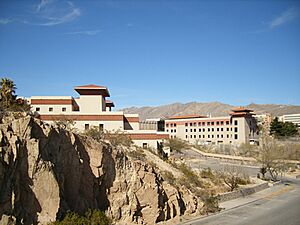
UTEP has achieved a lot in both academics and sports. In 1969, UTEP won its first of seven national championships in men's cross country running. In 1974, UTEP started its first doctoral degree program in Geological Sciences. That same year, UTEP won its first of seven national championships in men's indoor track and field. UTEP is one of only a few universities to win at least 21 national championships in different sports.
The campus grew in 1976 with new buildings. The College of Nursing was also started that year. In 1977, the Special Events Center (now called the Don Haskins Center) was built. It can hold 12,000 people for sports and concerts. The Sun Bowl Stadium was made even bigger in 1982, holding 52,000 people. The large University Library opened in 1984.
In 1988, Diana Natalicio became UTEP's first woman president. She was the longest-serving president of a major public research university when she retired in 2019. UTEP also started many new doctoral programs in different subjects during these years.
In 1999, UTEP started offering its MBA degree online. In 2000, it was recognized as a top research university. In 2002, the Larry K. Durham Sports Center opened. UTEP celebrated its 90th birthday in 2004.
In August 2019, Heather Wilson became UTEP's 11th president. She used to be the Secretary of the U.S. Air Force. As of August 2025, UTEP continues to work hard to meet all the standards set by its accrediting body, the Southern Association of Colleges and Schools.
Learning and Research at UTEP
| ARWU World | 801-900 |
|---|---|
| USNWR National University | 266 (tie) |
| Washington Monthly National University | 134 |
| Race and ethnicity | Total | ||
|---|---|---|---|
| Hispanic | 88% |
|
|
| International student | 4% |
|
|
| White | 4% |
|
|
| Black | 2% |
|
|
| Asian | 1% |
|
|
| Two or more races | 1% |
|
|
| Unknown | 1% |
|
|
| Economic diversity | |||
| Low-income | 60% |
|
|
| Affluent | 40% |
|
|
UTEP has nine colleges and schools. These offer many different types of degrees. Students can earn bachelor's, master's, and doctoral degrees. UTEP has 74 undergraduate degrees, 76 master's degrees, and 22 doctoral degrees. The school year is divided into spring, summer, and fall semesters, plus a short winter session in January.
UTEP is the only university in the USA that offers a special master's degree in creative writing that is taught in two languages.
In 2023, UTEP spent $145.7 million on research and development. This shows how much important research happens there. UTEP is known as an "R1: Research University," which means it has very high research activity.
Campus Architecture: A Touch of Bhutan
After a fire destroyed the original buildings in 1916, the school was rebuilt in 1917. Kathleen Worrell, the wife of the first dean, saw pictures of buildings in Bhutan. She noticed that the mountains in Bhutan looked like the mountains around El Paso. She suggested building the new campus in the style of Bhutanese dzongs. These buildings have massive sloping walls and overhanging roofs. Everyone loved this unique idea!
An architect named Charles Gisbon first designed the buildings in this style. Later, Henry Trost took over the designs. All buildings built until 1950 followed this special style. Even the student body voted in 2024 to remove some older buildings for a new campus plan.
The country of Bhutan is proud that UTEP uses their building style. A prince from Bhutan, Jigyel Ugyen Wangchuk, has even visited the campus. In 2009, Bhutan gave UTEP a hand-carved wooden temple. This temple was built on the campus.
Because of its Himalayan-style buildings, UTEP is also home to the Chenrezig Himalayan Cultural Center of El Paso. This is a place for Tibetan Buddhist culture.
School Colors and Logo
UTEP's original colors were orange and white. This was because it was part of the main University of Texas at Austin system. In the early 1980s, Columbia blue was added. Now, the official colors are orange, white, and blue. When a new sports logo was created in 1999, a darker blue and a silver accent were added to go with the orange.
UTEP Sports: The Miners!
UTEP was the first college in the American South to allow all students to play on its sports teams, regardless of race. This happened in the 1950s. When Don Haskins became the basketball coach in 1961, he looked for talented black players. In 1966, Haskins' team, the Miners, won the NCAA basketball championship. They beat the Kentucky team 72-65 in the final game. The Miners finished that season with an amazing 28-1 record.
At a time when many people thought black players couldn't play at a high level, Haskins started his usual players in the championship game. They were the first all-black team to start in a game at that level. This inspiring story was told in Haskins' book Glory Road (2005) and in the 2006 movie Glory Road. Haskins coached his whole career at UTEP. He won 719 games and lost 353. He was put into the Basketball Hall of Fame in 1997. The special events center was renamed the Don Haskins Center in his honor. He retired in 1999 and passed away in 2008. The entire 1966 UTEP team was also put into the Hall of Fame in 2007.
UTEP's sports teams have won a total of 21 national championships from the NCAA (National Collegiate Athletic Association). UTEP is tied for 10th place among all schools for men's sports championships in Division I.
- Men's basketball: 1 (1966)
- Men's cross country: 7
- Men's indoor track & field: 7
- Men's outdoor track & field: 6
UTEP has two of the biggest sports venues in El Paso:
- Sun Bowl Stadium: This stadium holds 51,500 people. It opened in 1963 and is home to the UTEP football team. It also hosts the yearly Sun Bowl game.
- Don Haskins Center: This arena holds 12,000 people. It was built in 1976 and is used by the men's and women's basketball teams. It's also called "The Bear's Den" or "The Don." Many famous musicians also perform concerts here.
- University Field (UTEP): This field holds 500 people and was built in 1991. It's where the women's soccer team plays.
- Kidd Field: This field holds 15,000 people and is home to the UTEP Track and Field teams.
In 2005, UTEP joined Conference USA.
In 2010, Tim Floyd became the head basketball coach. He was a student of Coach Haskins. He retired in 2017 and was replaced by Rodney Terry.
The Pickaxe Hand Symbol
This hand symbol looks like a pickaxe, which is a tool miners use. It's also similar to the shaka sign and the letter Y in American sign language. UTEP fans make this gesture when UTEP basketball players shoot free throws or when the football team kicks off. It started in the early 1980s with the UTEP cheerleading squad.
Why "Miners"?
The nickname "Miners" was first seen in the school newspaper, The Prospector, in February 1919. However, even earlier, in the bill that created the school in 1913, the author accidentally wrote "Miners" instead of "Mines." So, the school was called the "State School of Miners and Metallurgy." It's believed the nickname came from the school's original focus on mining. Some early ideas for nicknames were "Ore Diggers" and "Muckers." It's not clear if students voted on the name "Miners" or if a faculty member, John W. (Cap) Kidd, chose it. Kidd loved sports, especially football. The track facility on campus, Kidd Field, is named after him.
School Songs
"The Eyes of Texas" was chosen by UTEP students in 1920. It was already the school song for the University of Texas at Austin.
UTEP's first fight song, "Miners Fight," was also borrowed from the Austin campus. But in the late 1980s, UTEP's Music Department wrote new words to the tune of the famous country song "El Paso" by Marty Robbins. This gave UTEP its own unique fight song that many people recognize.
Friendly Rivalries
UTEP has a strong rivalry with New Mexico State University. This rivalry is called "The Battle of I-10" because the two universities are only about 40 miles apart.
Notable People from UTEP

Many talented people have studied or taught at UTEP.
Famous Alumni
- F. Murray Abraham – a well-known actor
- Tobi Amusan – a Nigerian track and field athlete
- Nate Archibald – a professional basketball player
- Bob Beamon – a famous track and field athlete and Olympian
- Sam Donaldson – a well-known American reporter and news anchor
- Tim Hardaway – a professional basketball player
- Aaron Jones – a professional football player
- Emmanuel Kipkurui Korir – a Kenyan middle-distance runner and Olympic athlete
- Suleiman Nyambui – a Tanzanian track athlete and Olympian
Images for kids
See also
 In Spanish: Universidad de Texas en El Paso para niños
In Spanish: Universidad de Texas en El Paso para niños
- List of universities in Texas by enrollment


